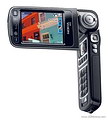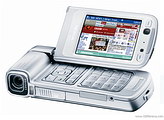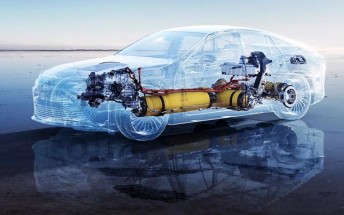Counterclockwise: Nokia 7650, 808, HTC EVO 3D, Galaxy K zoom
Counterclockwise is our weekly mobile tech history lesson and this time we're having a class on mobile cameras. There have been many impressive mobile shooters, but we'll focus on the stranger ones.

Camera on a phone
The idea of having a camera on a phone itself was pretty bonkers, the first mobiles to pull it off came in the early 2000's. Sharp was the first to launch a consumer product, the SCH-V200 and its 0.35MP camera that could take up to 20 shots in 2000. The first camera phone to make it to the US was the Sanyo SCP-5300 with a 0.3MP camera, it came a couple of years later.

Perhaps the best known "first" camera phone is the Nokia 7650, which also brought a 0.3MP camera, 4MB storage for the photos and a 2.1" 176 x 208px display to view them on.

Still, the first first phone with a camera came much earlier than you think – AT&T started experimenting with "two-way television telephone" system in the 1930s. Well, not mobile phones, of course. Eventually in 1964 AT&T launched the Picturephone with public booths to find home users. Of which there were few and the project was eventually a failure.
Note that the Picturephone and its predecessors did video chat, they didn’t capture photos. The first video call on a mobile phone took place in Johannesburg in 2004 over a nascent 3G network.
3D like the movies
Camera phones tried to better capture real life by increasing photo resolution and adding video, but they couldn’t get one thing right – depth perception. In a time before Avatar 3D movies were mostly forgotten, usually found in amusement parks, so a phone that captures 3D photos was an iffy proposition.
The Samsung SCH-B710 came first and brought its own 3D screen – no one had a 3D screen of their own at home. Sure, you could use clunky cyan-magenta glasses, but the B710 had plenty to overcome without mandating silly glasses.

That phone – as most other 3D attempts – used two cameras, one for each eye. Most early devices flew under the radar, but in 2011 both HTC and LG tried to revive the market. The HTC EVO 3D and LG Optimus 3D launched but failed to find a big enough audience.
The genre isn’t completely dead yet, late last year Huawei launched the Honor 6 Plus with dual cameras.
Depth, redux
Okay, the EVO 3D didn’t set the world on fire but HTC tried the two-camera approach again with the HTC One (M8). This time it wasn’t for 3D pictures, instead the second camera was used to calculate distances and create a shallow depth of field like you would get from an expensive DSLR.
A blurred background makes your subject pop, which is why it's such a popular technique in photography, but to do it with optics you need a big sensor and most phones do not have that.
HTC might have found some success, but it was late to the party – Nokia was already doing a very similar effect months earlier and with just one camera to boot. Nokia Refocus was shown off in late 2013 and while it was slower than HTC's approach, it worked.
Google released a similar effect for its Camera app around the time the One M9 launched, but makers did their own versions as well.

3D for real this time
3D photos taken with a dual camera have been around since the 19th century so smartphones were far from breaking new ground here. They only had a limited grasp of the 3D world around them, but Intel was set to change that.
The Dell Venue 8 7000 is among the first consumer products to use the Intel RealSense 3D tech. It uses three cameras – one for colors and two for depth – and it actually scans 3D objects. New Lenovo laptops using that tech promise to let you 3D print objects you've scanned.

Google is working on a similar technology and recently partnered with Qualcomm to release a Project Tango smartphone. That's a while out, but you can grab a Tango Tablet Development it from the Google Store right now.

Zooming in
3D photos get you a sense of distance, but what if you want to eliminate that distance? Digital zoom does little but ruin image quality, the trick is to use optics like traditional cameras do. The first mobile phone to pull it off was the Sharp V602SH, which launched on Vodafone Japan.
It had a 2MP camera with 2x optical zoom and could record 320 x 240px video at 15fps. The screen swiveled 180° so you can use the phone as a more traditional camcorder.
Nokia created a similar design a couple of years later with the Nokia N90, but without the zoom. It was the Nokia N93 in 2006 that added 3x optical zoom to the mix of 3.15MP camera with "DVD-like" video capture.
Recently Samsung has been dabbling with optical zoom, with the likes of the Galaxy Camera. Based on the Galaxy S III it packed 21x optical zoom and a 16.3MP sensor plus 1080p video recording. Its successor the Galaxy K zoom came out last year as a mid-range offering but the format is still to gain popularity.

Zoom, but without the optics
Part of the reason phones with optical zoom aren’t very popular is that the mechanics and optics required are thick and heavy, nothing that will fit in today's sub-8mm landscape. Nokia tried a different approach – throw megapixels at it.
Asus tried fighting that with a different camera design for the Zenfone Zoom. It used a periscope type zoom, the kind you see in waterproof cameras without extensible lens. The moving lens are inside the body of the device and stay there, this allowed Asus to go down to just 12mm (the camera still protrudes a bit though).

Digital zoom works by cropping the center of the image and optionally upscaling the result back to the original resolution. This does little but spoil the image quality.
The Nokia 808 PureView, however, brought an unbelievable 41MP sensor, preferred making photos with more manageable resolutions – 3MP, 5MP or 8MP. In those modes it could zoom up to 4x for stills and videos without sacrificing quality.
The Nokia Lumia 1020 worked the same magic, but this time on a modern platform as 808's Symbian OS was sunsetted.

The magic works because while other phones have to upscale images to bring them back up to their advertised resolution, the 808 and 1020 actually had to downscale images to get them to 5MP. Nokia couldn’t escape the thickness though – even though no zoom mechanism was required, the size of the sensor needed to reach 41MP was just too big to fit in a thin phone.
Dual lens cameras may come back to try zoom again. A prototype module had two cameras with different Fields of View, that is the second camera is zoomed in. Special software interpolates between the zoomed out and zoomed in cameras to simulate classic optical zoom.
Add-on camera
If constantly lugging around a big zoom lens isn’t what you want, what if you could use it when needed and then put it away? Sony did just that with the QX10 and Q100 "lens-style" cameras. They are complete cameras – with optics, zoom and sensor – that communicate wirelessly with your phone.
This allows for large sensors to be included, the current top model is the Sony QX1, which uses the sensor from the Sony α5000 platform, a 20.1MP APS-C sensor and even has a lens mount so you can use different high-quality lenses. It's as close to mobile phones have gotten to prosumer quality photography yet.
Interactive demo:
Related
Reader comments
- Markius Lanzius
- 15 Jun 2015
- B{9
In 2002 I had a 7650, and I upgraded the camera by installing a video recording app (Nokia_7650_Videorecorder.SIS) from the Nokia website. I copied it to a floppy disk on a local netcafe PC, put the disk into my laptop and beamed it to the phone via ...
- heynekko
- 15 Jun 2015
- ibe
I had both 7650 and 808.. Best phone ever. The 7650 had copy n paste, multitasking, task manager on a 2003 phone
- Anonymous
- 15 Jun 2015
- trb
HTC Evo 3D is best phone, I have been use it as dream have 1 pcs. It is 1st smart phone that i had use. it very good with good price... Thank HTC brand has bring smart phone for everyone






















 Huawei
Huawei Samsung
Samsung Samsung
Samsung Apple
Apple Xiaomi
Xiaomi


